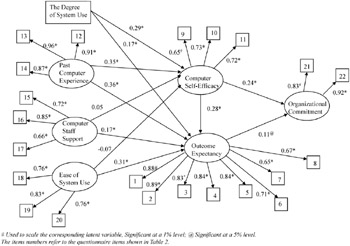The Estimation of the Model
|
| < Day Day Up > |
|
The theoretical model shown in Figure 1 was estimated using Calis in PC SAS version 6.12. The estimation method used was maximum likelihood. The fit of this model to the data was good. The specific details of the estimation results are discussed in the Appendix. The results pertaining to the theoretical model are shown in Figure 2 and summarized here.

Figure 2: The Empirical Results of the Estimated Model Using Standardized Path Coefficients
Based on the results, several general statements are possible. All paths from the measures to their indicants that were free to vary had estimates that were statistically significant at a 1% level. All but one disturbance term had an estimated standard deviation that was statistically significant at a 1% level. The one indicant with an insignificant estimate for the standard deviation of the disturbance term was associated with organizational commitment. Several of the paths among the measures had estimated values that were statistically significant and sufficiently large to be meaningful. Measures having significant paths to both computer self-efficacy and outcome expectancy were past computer experience and the degree of system use. Ease of system use and computer staff support had significant impacts on outcome expectancy, but not on computer self-efficacy. Computer self-efficacy had a significant path to outcome expectancy. Both computer self-efficacy and outcome expectancy had significant impacts on organizational commitment.
|
| < Day Day Up > |
|
EAN: 2147483647
Pages: 191